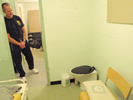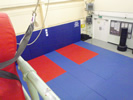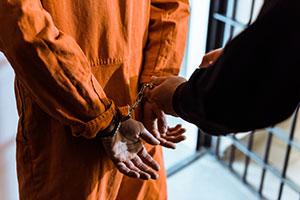Prison Officer Dave Littlefair has been teaching Control and Restraint (C&R) techniques for the last ten years. Six months ago he was appointed to the post of NW Prison Officer Entry Level Training (POELT) Co-ordinator. His daily task is to supervise the eight week training course within which he is the specialist C&R Instructor and Examiner.The course includes a gap week during which delegates return to their home posting for practical experience.
 Good morning Dave, I’ve come to you to learn a bit about the initial training of prison officers and especially about the methods associated with the teaching of control and restraint techniques. So how are you involved?
Good morning Dave, I’ve come to you to learn a bit about the initial training of prison officers and especially about the methods associated with the teaching of control and restraint techniques. So how are you involved?
Dave Littlefair (DL) I am the co-ordinator of the NW Prison Officer Entry Level Training Course, POELT for short, and responsible for providing Control and Restraint training for the new recruits . We work to a specific scheme of work which is the same as at P.S.C Newbold Revel and the other satellite stations.After each session, I see each student on an individual basis and discuss their performance and any related problems they might be having; any slow learners might be the subject of individual learning plans.
I understand you have been teaching these techniques for a long time. Can you say how much things have changed over that period?
DL Control and Restraint is being continually revised and refined, but throughout the last few years there has

been little change except for the Personal Protection package. We need to ensure that the new and inexperienced officers realise what an important and huge subject it is. On the first morning of the course, in the classroom, we cover where we get the authority to use force, the principles behind the techniques and when its use is lawful. We emphasise that force has to be necessary , proportionate , no more force than necessary and a last resort .We also look at how to recognise, handle and understand the causes of aggression, how to be assertive and we look at reaction distances; so there is a lot done in the classroom before the practical work on the mat begins.
So great emphasis is placed on doing the work absolutely correctly?
DL That’s right! We cannot afford to be complacent and we teach C&R exactly as it says in the manual. It is amazing to see the students confidence and ability improve throughout the six weeks and it gives me a lot of satisfaction to see them pass their assessments at the end of the course. In addition to the initial courses, we also teach experienced officers who have to be given a one day basic Control and Restraints refresher every 12 months.

Precisely how does a Prison Officer protect him/herself?
DL We practise doing things we would do in a real situation. For example, if you have an aggressive prisoner to deal with and you are alone, you protect yourself with a push, punch, knee strike, shin kick and/or the use of a baton depending on the situation. After that, we go on to revise and practise C&R techniques which involves a team of three officers. We look at controlling a prisoner stood-up, from behind, on his front, on his back, moving and re-locating a prisoner.
I can see a row of cells in the training area.What are they for?
DLThe first two cells are changing rooms and the rest are all training aids. All the cells have proper cell doors because officers on the POELT course can practise unlocking and opening a cell door; it can be quite difficult at
first, and here we have a realistic training environment to do that. Cell searching and other procedures such as A.F.C.s are carriedout in the end two cells.
I know what a cup of Oxo is but why have you got it written on the walls?
DL It’s the main buzzword, a safety factor, in teaching C&R techniques.Anyone who shouts ‘OXO’ is in, or has observed, some form of possible trouble and everything stops until it is sorted.
How do you get people to understand about invading personal space? I do quite a bit of martial arts training and

find it, as do others I speak to, a problem at first. One is naturally hesitant about laying hands on other people. How do you get over that in training?
DL The first thing is that we tell the students to avoid making contact; there is nothing wrong with taking a backward step, then telling the prisoner to stay where he is while using non-verbal communication, that is calming gestures, to resolve the situation. Common sense and experience helps in the long run. Physical contact can and should be avoided. If that fails then there are personal protection techniques and C&R as the last resort.
Thank you for taking time out from your training schedule to speak with the Review

 Good morning Dave, I’ve come to you to learn a bit about the initial training of prison officers and especially about the methods associated with the teaching of control and restraint techniques. So how are you involved?
Good morning Dave, I’ve come to you to learn a bit about the initial training of prison officers and especially about the methods associated with the teaching of control and restraint techniques. So how are you involved? 




